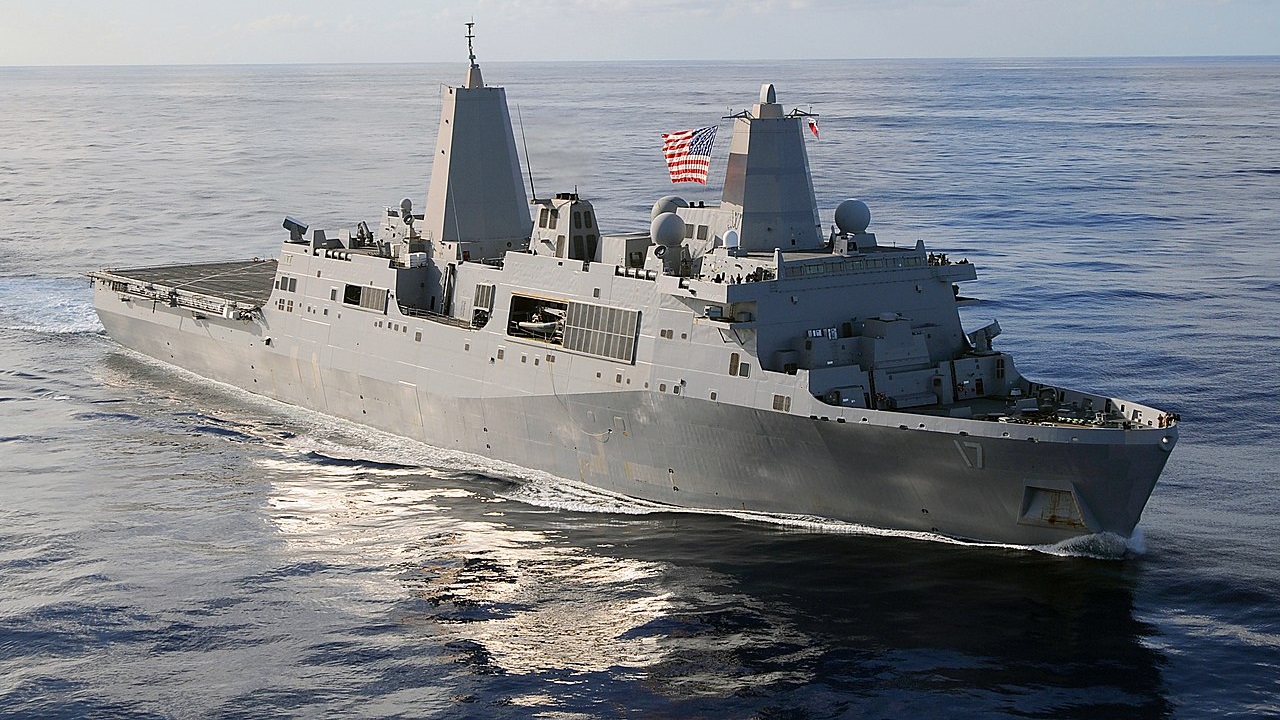The United States Navy’s fleet of amphibious transport docks – also known as “landing platform, dock” (LPD) – don’t typically get the same level of attention as aircraft carriers or even destroyers. Yet, these vessels remain critical workhorses that provide the U.S. Navy and U.S. Marine Corps with modern, sea-based platforms that can ferry troops, aircraft, land vehicles, and landing craft to distant shores.
It was just last week on June 11 that the builder of the vessels, Huntington Ingalls Industries (HII), announced that its Ingalls Shipbuilding division christened the 13th and final San Antonio-class amphibious transport dock, USS Richard M. McCool Jr. (LPD-29). The ship was named to honor U.S. Navy Capt. Richard M. McCool Jr., who was awarded the Medal of Honor for his heroic actions in rescuing survivors from a sinking destroyer and for saving his own landing support ship during a World War II kamikaze attack. In addition, his rescue efforts took place exactly 77 years before the day LPD-29 was christened.
“Richard M. McCool Jr. truly embodied the spirit of service above self,” said Under Secretary of the Navy Erik Raven, the ceremony’s keynote speaker. “The sailors and Marines who will sail on this future ship carry on that legacy following the example of spirit, patriotism and selflessness set by Richard M. McCool Jr.”
A Drone Mothership or Drone Aircraft Carrier?
In addition to transporting troops and material around the globe, the San Antonio-class LPDs could soon be used as drone motherships. HII announced on Monday that it completed the successful demonstration of capabilities enabling amphibious warships to launch, operate with, and recover HII-built large-diameter unmanned underwater vehicles (LDUUV).
The launch and recovery demonstration was carried out by HII’s Advanced Technology Group using a prototype dubbed the Pharos and HII’s Proteus LDUUV. It was part of a research and development initiative conducted between HII’s Ingalls Shipbuilding and Mission Technologies divisions, while three main partners supported the development. The University of New Orleans, in conjunction with the U.S. Navy, performed the initial model testing, and the prototype device was fabricated by Metal Shark in Louisiana.
“HII is committed to advancing the future of distributed maritime operations and demonstrating our capability to support unmanned vehicles on amphibious ships,” said Kari Wilkinson, president of Ingalls Shipbuilding, which hosted and partnered in the demonstration. “I am very proud of our team’s initiative to strengthen the flexibility of the ships we build by anticipating the challenges and opportunities that exist for our customers.”
Proteus is a large-class UUV and can be configured to test sensors, autonomy, payloads, energy storage systems, and other technologies. It is equipped with forward-looking sonar, cameras, a variable buoyancy system, baseline 148 kWh energy; extended range options, and 170 cubic feet of customizable cargo volume with external cargo capacity.
First Test Completed
The recently concluded demonstrations took place along the Pascagoula River in Mississippi and involved having the LDUUV approach and be captured by the Pharos cradle, while Pharos was towed behind a small craft that simulated an amphibious ship at low speed. Pharos was put in a tow position, then using a remote control, it was ballasted down in the trailing position allowing the LDUUV to navigate into the recovery vehicle, HII announced.
Once the unmanned vehicle was captured, Pharos was deballasted back up into a recovery and transport position. The demonstration also included ballasting down to launch the LDUUV after the capture.
The Pharos prototype was outfitted with heavy-duty wheels, which provided transport maneuverability within the well-deck of an amphibious ship as well as for stowage on the vehicle decks. As a result, Pharos could be rolled off the back of an amphibious ship while using the ship’s existing winch capabilities to extend and retract the platform from the well-deck. The Pharos design is scalable and reconfigurable to fit various unmanned underwater or unmanned surface vehicles.
The recent test, conducted in the calm waters of the Pascagoula River, was the first of what will certainly be many to come. HII is currently exploring modifications for other UUVs that will participate in live demonstrations with the fleet within the next year. HII has announced that it will use the results from the Pharos demonstration to further mature concepts and continue to develop innovative national security solutions.
Now a Senior Editor for 1945, Peter Suciu is a Michigan-based writer who has contributed to more than four dozen magazines, newspapers and websites. He regularly writes about military hardware, firearms history, cybersecurity and international affairs. Peter is also a Contributing Writer for Forbes.

